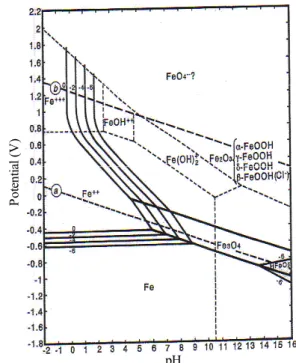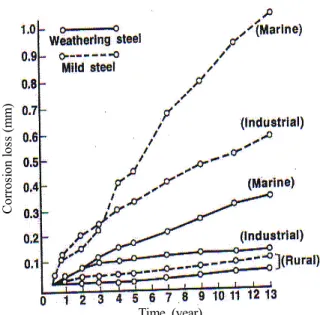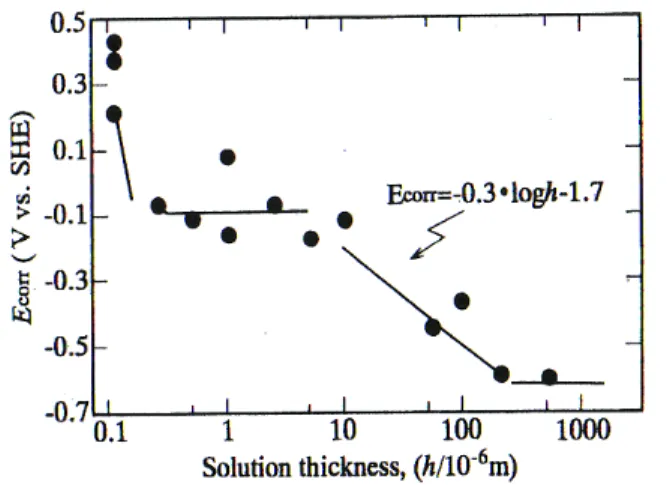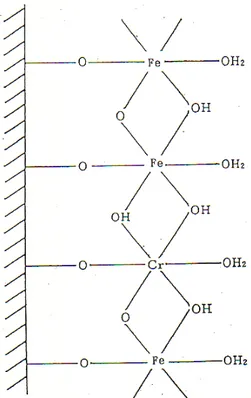Atmospheric Corrosion Process for Weathering Steel
Hiroo Nagano1,†and Masato Yamashita2
115-14, Uozaki Kitamachi, Higashinadaku, kobe, Hyogo, 658-0082, Japan
22167, Shosha, Himeji, Hyogo, 671-2201, Japan
Steel is generally not corrosion resistant to water with formation of non protective rusts on its surface.
Rusts are composed of iron oxides such as Fe3O4, α-, β-, γ-and δ-FeOOH. However, steel, particularly weathering steel containing small amounts of Cu, Ni and Cr etc., shows good corrosion resistance against rural, industrial or marine environment. Its corrosion rate is exceedingly small as compared with that of carbon steel. According to the exposure test results undertaken in outdoor environments, the atmospheric corrosion rate for weathering steel is only 1 mm for a century. Atmospheric corrosion for steels proceeds under alternate dry and wet conditions. Dry condition is encountered on steel surface on fine or cloudy days, and wet condition is on rainy or snowy days. The reason why weathering steel shows superior atmospheric corrosion resistance is due to formation of corrosion protective rusts on its surface under very thin water layer. The protective rusts are usually composed of two layer rusts; the upper layer is γ-FeOOH termed as lepidocrocite, and inner layer is nano-particle α-FeOOH termed as goethite. This paper is aimed at elucidating the atmospheric corrosion mechanism for steel in comparison with corrosion in bulky water environment by use of empirical data.The summary is as follows:
1. No corrosion protective rusts are formed on steel in bulky water.
2. Atmospheric corrosion for steel is the corrosion under wetting and drying conditions. Corrosion and passivation occur alternately on steel surface. Steel, particularly weathering steel with small amounts of alloying elements such as Cu, Ni and Cr etc. enhances forming corrosion protective rusts by passivation.
Keywords : atmospheric corrosion, weathering steel, wet and dry conditions. protective rust, passivation, α-FeOOH, γ-FeOOH, Fe3O4、thin water layer, bulky water.
†Corresponding author: hiroonagano@ybb.ne.jp
1. Introduction
Steel is generally not corrosion resistant to water with formation of non-protective rusts on its surface. Rusts are composed of iron oxides such as Fe3O4 and α-. β-, γ -and δ-FeOOH. However, steel, particularly weathering steel containing small amounts of Cu, Ni and Cr etc., shows good corrosion resistance against rural, industrial or marine environment. Its corrosion rate is exceedingly small as compared with that of carbon steel. According to the exposure test results undertaken in outdoor environ- ments, the atmospheric corrosion rate for weathering steel is only 1 mm or so for a century due to formation of protective rusts.
Research on the corrosion of steel in the atmosphere has recently been very active from the practical point of view. However, fundamental approach to the difference in the corrosion rates of steel between corrosion in bulky water and in the atmosphere has not sufficiently been
discussed. Steel forms the same kinds of iron rusts both in bulky water and the atmosphere, but it has not well been known why steel is attacked heavily in bulky water, and scarcely attacked in the atmosphere. Generally speak- ing, atmospheric corrosion of steel is retarded after pro- tective rust is formed. However, not small corrosion is still encountered in weathering steel under almost all the time wetted condition.
Therefore, the paper is aimed at elucidating the atmos- pheric corrosion mechanism for steel in comparison with corrosion in bulky water environment by use of empirical data.
2. Aqueous corrosion in bulky water
Corrosion of steel in water is affected to a great extent by volume of water. Fig. 1 shows corrosion in both envi- ronments: corrosion under thin water layer and in bulky water. Thin water layer has higher transportation of oxy- gen from the atmosphere to metal surface than bulky wa- ter, and makes it easier for steel to precipitate ferric hy-
Fig. 1. Corrosion of steel under thin layer of water or in bulky water.
droxides after reaching their solubility products. Therefore, at the beginning of corrosion under thin water layer, steel corrodes fast, but soon corrodes considerably slowly with formation of protective rust composed iron hydroxides. On the other hand, since it is very difficult for protective rust to be formed in bulky water, not a low corrosion rate con- tinues in steel.
Aqueous corrosion of steel proceeds in bulky with non protective rust formed. Corrosion is controlled under dif- fusion of oxygen. Corrosion of steel increases with flow velocity, reaching the maximum corrosion rate, and then decreasing as shown in Fig. 2.1) Increase in corrosion rate with flow velocity is due to increase in diffusion rate of oxygen to metal surface. Decrease in corrosion rate at the velocity more than 0.5 m/sec is due to the partial passiva- tion of steel. Anyway, corrosion rate for steel in bulky water, both stagnant and flowing, is exceedingly higher than in thin water layer.
Anodic dissolution: Fe = Fe2+ + 2e- (1) Cathodic reduction: 2H2O + O2 + 4e- = 4OH- (2) Overall: 2Fe + 2H2O + O2 = 2Fe(OH)2 (3) Oxidation: 3Fe(OH)2= Fe3O4+ 2H2O + 2H++ 2e- (4) Fe(OH)2= FeOOH + H++ e- (5) Fe3O4, -FeOOH, γ-FeOOH, β-FeOOH and -FeOOH are possibly stable iron rusts. Rusts, ferric oxyhydroxides are precipitated on iron surface in neutral water. Growth of rust is written in the following equation.2)
Rg = kg (Δc-1)n, Δc>1 (6) Rg: the rate of rust growth
kg: the effective rate constant for rust growth
Δc = Ion activity product of iron ion and OH-/Ksp (7) Ksp: the solubility product of iron ion
Flow velocity (m/sec)
Corrosion rate (mm/y)
Fig. 2. Corrosion rates of various steel and alloys in flowing Tap water at 35°C.
pH
Potential (V)
Fig. 3. Potential-pH equilibrium diagram for iron- water system at 25°C.
Corrosion products formed on steel in bulky water are usually dual layers, inner layer of Fe3O4 and outer layer of α-FeOOH and γ-FeOOH. Fig. 3 shows the poten- tial-pH diagram for iron-water system. The corrosion rusts formed on steel in bulky water are of coarse grains and have many pores, therefore, having no good corrosion protection.
3. Atmospheric corrosion
Fig. 43) is the schematic showing the effect of water thickness on corrosion of iron. The figure is very interest- ing in the point that iron corrodes at the maximum under the critical water thickness from dew to wet condition.
However, this description refers to the initial stage of corrosion. As time goes on, corrosion products are easily precipitated on metal surface, then rapid decrease in corro- sion rate will appear under very thin water film. Therefore, the corrosion rate of iron under dew and wet condition will be remarkably less than in dip condition.
Iron and steel corrodes in the atmosphere in the stage of Fe→ Fe2+→Fe(OH)2→Fe(OH)3→α- or γ-FeOOH.
Fig. 5 is the exposure test results of steel and weathering steel for up to thirteen years. Weathering steel containing small amounts of Cu, Ni and Cr etc. is more corrosion resistant than steel in marine, industrial and rural environments. Atmospheric corrosion rate is less in rural<
industrial< marine larger. It is assumed that atmospheric corrosion proceeds in the repetition of wet and dry con- dition ; active dissolution occurs in the wet condition, and protective rust formation takes place in the transitional condition of wetting to drying, resulting in retardation of corrosion.
Fig. 4. Relationship between atmospheric corrosion and water thickness.
Corrosion loss (mm)
Time (year)
Fig. 5. Atmospheric exposure test results for carbon steel and weathering steel.
4. Passivation and depassivation of steel in the atmospheric corrosion process
Steel corrodes at low corrosion rate in the atmosphere as compared with the corrosion in tap water or sea water.
Corrosion of steel in the atmosphere proceeds in the repeti- tion of wetting and drying. It is assumed that low atmos- pheric corrosion rate of steel is related with passivation of steel in the wet-dry transitional stage. This passivation behavior of steel is somewhat different from that of stain- less steel. Stainless steel can be passivated not only under thin water layer, buto also in bulky water. However, passi- vation of steel is possible solely under thin layer of water.
Fig. 6 shows the schematic of the Kelvin probe, which can measure the contact potential difference between the reference electrode R and the metal covered with thin wa- ter layer.
Iac(t) = (ΔV - Vkp)․dC(t)/dt (8) When iac = 0, then
Vkp = ΔV (9)
Vkp = Ecorr. + Constant (10)
Whereas,
Iac: the alternate current
ΔV: the contact potential difference Vkp: the Kelvin potential
C: the capacitance of the couple R and M t: time
Fig. 6. Schematic of the Kelvin probe.
Fig. 7. Effect of solution thickness on Ecorr.
Thickness of water layer affects considerably the corro- sion of steel. Fig. 74) shows the relationship between corro- sion potential of weathering steel and thickness of 1 M Na2SO4 solution. Weathering steel is in the active dis- solution state in the solution thickness more than 200 μm.
As solution thickness decreases, the corrosion potential increases. Weathering steel get passivated in the solution thickness below 10 μm.
The corrosion rate of weathering steel responds to the potential change. As shown in Fig. 8,4) the maximum cor- rosion rate is encountered on weathering steel under the solution of 10 μm thickness, and decreases remarkably passivtion occurs.
Fig. 9 shows corrosion potential for weathering steel and carbon steel under thin water layer. They were ex-
Fig. 8. Effect of solution thickness on corrosion
Time (s)
Potential / V vs. Ag-AgCl
Fig. 9. Corrosion potentials for carbon and weathering steels exposed in the marine atmosphere for seventeen years.
posed in the marine atmosphere for seventeen years, and covered with rust. The rust is composed of two layers;
inner layer of -FeOOH adjacent to metal surface and outer layer of γ-FeOOH. Weathering steel has shown better atmospheric corrosion resistance than carbon steel. It can be understood that rusted weathering steel is often in the passive state, whereas, carbon steel is rather often in the active state.
Owing to good atmospheric corrosion resistance and economical price, weathering steel has widely been used as the constructional material for container, highway, bridge and steel tower etc. It contains small amounts of copper, nickel, chromium, and sometime additionally phosphor. Good atmospheric corrosion resistance of wea- thering steel is elucidated by formation of compact two
layer rust, inner -FeOOH and outer γ-FeOOH. Precisely speaking, -FeOOH is -(Fe1-x, Crx)OOH, and nano-size rust.
This type of rust is termed as protective rust. The chemical structure of -FeOOH is shown in Fig. 10. The structure is depicted almost similar to the passive film structure of stainless steel. Alloying elements such as copper, nickel, chromium and phosphor improve atmospheric corrosion resistance of steel; copper improves acid corrosion resist- ance, nickel is beneficial for prevention of marine atmos- phere corrosion, and chromium and phosphor are useful in building protective rust.
Appropriate thin water layer condition is encountered at the stage from wetting to drying. Steel can be passivated under this condition. Contrary to stainless steel, the passive state of weathering steel is destroyed easily by long time immersion in thick water layer, e.g., under rain droplets.
Through the seasons, weathering steel experiences passiva- tion and depassivation, and its rust gets compacted and more protective against atmospheric corrosion. Fig. 11 proposes the cycle of rust formation. Iron and steel are oxidized finally to -FeOOH and γ-FeOOH. The former is a stable final product, and won’t be reduced. Whereas, the latter will be reduced to Fe(OH)2. -FeOOH is one of the major elements forming protective rust.
There are two ways for formation of -FeOOH;
One is crystallization of -FeOOH from amorphous FeOOH as shown in Fig. 11. The other hypothesized way
Fig. 10. Chemical structure of protective rust, -(Fe1-xCrx)OOH.
Fig. 11. Cycle of rust formation.
is direct oxidation of Fe(OH)2 to -FeOOH. The appropriate condition is encountered on metal surface under thin water layer below γ-FeOOH rust.
5. Summary
1) Steel corrodes considerably in aqueous solution.
Although such iron oxide and ferric oxyhydroxides as Fe3O4, -FeOOH and γ-FeOOH are formed on metal sur- face, they are voluminous and non protective against corrosion.
2) As for corrosion of steel under thin water layer, first steel corrodes to a great extent due to high supply of oxy- gen compared with corrosion in bulky water, secondly steel gets passivated due to precipitation of iron ferric oxy- hydroxides under thin water layer.
3) Atmospheric corrosion of steel is corrosion under re- peated wetting and drying. Steel is in the active dissolution state in the wet condition, and in the passive state in the transitional state of wetting to drying.
4) When steel is exposed all the time to wet condition, non protective rust is formed and not little atmospheric corrosion proceeds. While steel is exposed to alternate wetting and drying condition, protective rust is possible to be formed. Good atmospheric corrosion resistance is expected for steel under such condition.
5) Protective rust is composed of inner layer of -FeOOH and outer layer of γ-FeOOH. -FeOOH, particularly nano-size -FeOOH is responsible for good atmospheric corrosion resistance. Since weathering steel containing small amounts of copper, nickel and chromium etc. forms nano-size -(Fe1-xCrx)OOH, it shows exceedingly superior atmospheric corrosion resistance to carbon steel.
References
1. H. Nagano, Netsushori (Japanese), 35, 2 (1995).
2. C. Leygraf and T. E. Graedel, Atmospheric Corrosion, p.32, A John Wiley and Sons (2000).
3. N. D. Tomashov, Theory of Corrosion Protection of Metals, p.367, MacMillan Comp (1966).
4. M. Yamashita, H. Nagano, and R. A. Oriani, Corr. Sci., 40, 1447 (1998).
5. H. Nagano, M. Yamashita, and S. Suzuki, J. Soc. Mat.
Sci., 44, 1314 (1995).
6. M. Yamashita, H. Nagano, T. Misawa, and H. E. Townsend, ISIJ, 38, 285 (1998).



